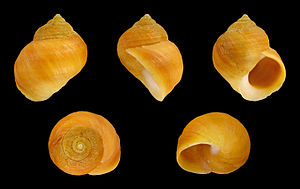Small periwinkle
| Small periwinkle | ||||||||||||
|---|---|---|---|---|---|---|---|---|---|---|---|---|

Small periwinkle ( Littorina saxatilis ) |
||||||||||||
| Systematics | ||||||||||||
|
||||||||||||
| Scientific name | ||||||||||||
| Littorina saxatilis | ||||||||||||
| ( Olivi , 1792) |
The rock periwinkle , also called small or rough periwinkle ( Littorina saxatilis ), is a sea snail from the family of Littorinidae (periwinkles).
features
The shell of the rock perimeter snail is tightly shelled, conical and only moderately high. The outer edge is almost straight, the whorls are slightly curved outwards. It grows up to 1.7 centimeters high. The outside has spiral grooves and fine growth strips. The color of the small periwinkle is variable, mostly yellowish to brownish. The gill has receded and the mantle cavity has been converted into a kind of lung that can also absorb oxygen from the atmosphere.
Similar species
The small periwinkle can easily be confused with the other smaller periwinkles such as the pointed periwinkle ( Littorina neritoides ) and the flat periwinkle ( Littorina obtusata ). Compared to the periwinkle, the perimeter of the house is more curved.
Geographical distribution and habitat
The rock periwinkle is widespread on the North European and North American Atlantic coasts. It also occurs in the North Sea and in the western Baltic Sea (up to Rügen). She was abducted to San Francisco Bay . It lives in the shallow water of the upper tidal zone, but also up to 2 m above the water level (flood and splash zone) in crevices and small cave systems.
Way of life
The rock periwinkle migrates at night from their resting places in crevices and small cave systems to their pastures, where they graze on algae growth on stones or young shoots of seaweed. In the morning she returns to her resting place. It tolerates low salinity up to 5 ‰.
As an adaptation to life in the flood zone of the beaches, this Littorina species is viviparous . The fertilized eggs (from 40 to about 500 pieces) are carried by the mother in the edge of the coat until small, fully developed young animals hatch from the eggs. These then leave the mantle cavity of the mother animal. They can live to be around six years old.
Systematics
In the classical system, this family belongs to the middle snails (Mesogastropoda), an order of the front gill snails (Prosobranchia). In the (new) phylogenetic system used here, this classification was abandoned, the Littorinidae are placed here in the order Sorbeoconcha .
swell
literature
- Rosina Fechter / Gerhard Falkner: Mollusks . Mosaik-Verlag, Munich 1990, ISBN 3-570-03414-3 , ( Steinbach's natural guide 10).
- Bernhard Grzimek (ed.): Grzimeks animal life. Encyclopedia of the Animal Kingdom in 13 volumes. Volume 3: molluscs and echinoderms. Unchanged reprint of the dtv edition from 1979/80. Bechtermünz-Weltbildverlag, Augsburg, 2000 ISBN 3828916031
- Rainer Willmann: Mussels and snails of the North and Baltic Seas. 310 pp., Neumann, Neudamm 1989 ISBN 3-7888-0555-2
Individual evidence
- ^ Willmann (1989: p. 230)
- ↑ Guide to the Exotic Species of San Francisco Bay - Littorina saxatilis